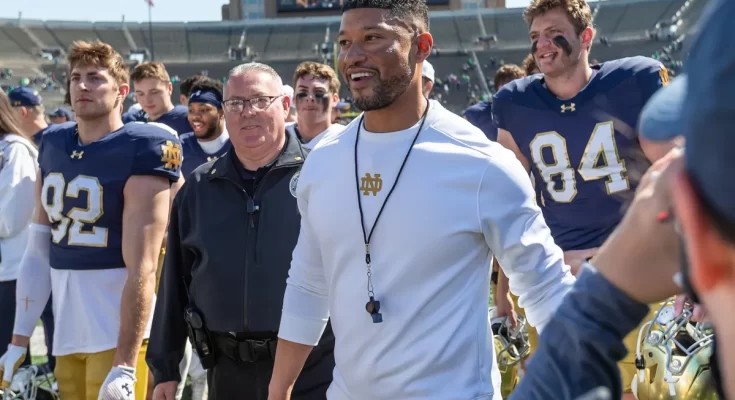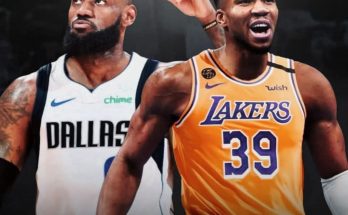Throughout June, Notre Dame emerged as one of the nation’s premier recruiting powerhouses, consistently landing top-tier talent and reinforcing the strength, depth, and future outlook of its upcoming class.
Throughout the month of June, Notre Dame demonstrated why it continues to be a formidable presence on the national recruiting landscape, not just in tradition or name recognition, but through a dynamic and results-driven strategy that yielded an impressive wave of commitments. The Fighting Irish capitalized on a strong blend of on-campus visits, elite camp performances, national exposure, and relationship-building to secure a series of top-tier recruits, positioning themselves among the country’s premier programs in the 2025 recruiting cycle. The momentum created during this critical summer stretch didn’t just reinforce existing expectations—it elevated the perception of Notre Dame’s trajectory moving forward under its current leadership.
Notre Dame’s recruiting team, led by head coach Marcus Freeman, has embraced a relentless and modernized approach to talent acquisition, one that emphasizes not only identifying elite prospects but also creating lasting impressions during visits and virtual engagements. The groundwork laid in the spring paid massive dividends as the Irish coaching staff welcomed a parade of highly-rated players to South Bend throughout June. These visits weren’t just routine tours—they were immersive experiences that showcased everything Notre Dame has to offer, from academic prestige and athletic tradition to state-of-the-art facilities and a growing vision of competitiveness on the national stage.
Recruits took notice. From coast to coast, top players began to include Notre Dame in their final lists, make verbal commitments, and even recruit peers to join them. Perhaps more significantly, these weren’t just positional fillers—they were blue-chip athletes who had their choice of powerhouse programs yet chose to align themselves with Notre Dame’s mission. This speaks to the program’s broader appeal: a blend of elite football development, cultural fit, and life-after-football promise. June proved that Notre Dame could go head-to-head with the likes of Alabama, Georgia, Ohio State, and USC—and win.
Among the notable additions was a strong contingent of defensive standouts, who were drawn to Notre Dame’s increasingly aggressive, NFL-style defense. The coaching staff emphasized player versatility, early playing time opportunities, and personalized development plans. Defensive ends and linebackers, in particular, responded positively, with multiple high-profile commitments locking in their pledges after visiting campus and meeting with position coaches. These defenders brought with them not only impressive film but also high academic profiles and leadership traits that align with Notre Dame’s standards.
Offensively, June was equally productive. Notre Dame targeted and secured commitments from several high-upside skill position players, including wide receivers with elite separation speed and quarterbacks with both arm talent and mobility. Offensive line recruiting—long a hallmark of the program—continued to thrive, with trench players drawn to the legacy of producing NFL linemen and the opportunity to play for position coaches with proven track records. Each addition reflected a calculated pursuit of not only physical talent but also character and fit. Freeman and his staff have made it clear that they’re not chasing stars—they’re building a team culture, one recruit at a time.
What made this month particularly noteworthy was the balance of immediate impact players and long-term developmental prospects. Notre Dame didn’t just load up on five-stars—they identified three- and four-star recruits whose ceilings are remarkably high. By prioritizing traits such as coachability, work ethic, and football IQ, the Irish ensured that their class would not only be rated well on paper but also produce results on the field and in the locker room. The coaching staff spent time analyzing each player’s trajectory, not just in terms of recruiting rankings, but how they would fit into future schemes and team dynamics.
Much of the momentum can also be attributed to the unified vision across the program. From Freeman to position coaches to off-field support staff, the message being delivered was consistent: Notre Dame is not just chasing championships—it’s building a sustainable powerhouse. The players responded to this clarity. They saw a program that has embraced change without losing its identity, one that offers top-tier football opportunities while maintaining a commitment to academic excellence and personal development. For many recruits, this holistic approach was the deciding factor.
Several of the commitments made headlines, not only because of the talent level but because of the programs Notre Dame beat to secure them. In multiple cases, the Irish landed players who had previously trended toward SEC schools or were thought to be locks elsewhere. The flip of a previously committed recruit sent a shockwave through the recruiting community, reaffirming Notre Dame’s growing pull. Social media buzzed with images of recruits posing in the golden helmets, signaling a cultural resurgence that resonates with the next generation of players.
Another major asset during this period was the active role that current players and recent alumni played in the process. Recruits mentioned how impactful it was to hear from athletes who have lived the Notre Dame experience. These player-to-player connections brought authenticity and relatability to the process, reinforcing everything the coaching staff was pitching. The bond among players, the work ethic in practice, and the love for the school—all of it resonated in conversations, creating a family atmosphere that’s difficult to manufacture but easy to feel once you’re on campus.
Notre Dame’s June haul also spoke to a broader national footprint. The staff didn’t just dominate locally or regionally—they pulled commitments from several states, including football-rich areas like Texas, Georgia, California, and Florida. This national reach reflects both the strength of the brand and the adaptability of the recruiting approach. Each region presented unique challenges, but the Irish navigated them skillfully, building trust with families, adapting to scheduling needs, and remaining transparent throughout the process. The result was a geographically diverse class that mirrors the national stage on which Notre Dame competes.
Even as the month concluded, the buzz around the program didn’t fade. Recruits who didn’t commit publicly still left South Bend impressed, hinting at future decisions that could further strengthen the class. Silent commitments, social media teasers, and crystal ball predictions all pointed toward continued success. The sense among insiders was clear—Notre Dame wasn’t finished. The dominoes were falling, and each new commitment added weight to the growing perception that something special is being built in South Bend.
The coaching staff’s use of modern recruiting tools and analytics was also on display. From film breakdowns to data-driven performance assessments, prospects were impressed by the level of detail in their evaluations. The staff didn’t just pitch playing time—they presented plans for how each player would be used, what areas they needed to improve, and how Notre Dame would help them get there. This transparency and forward-thinking approach resonated especially with families, who appreciated the honesty and preparation involved in the process.
As June gave way to July, Notre Dame found itself with one of the top recruiting classes in the nation—not just in numbers, but in quality and balance. The class featured high-impact talent across the board: explosive athletes, cerebral quarterbacks, disciplined linemen, and defenders with both range and ferocity. There was no glaring weakness. It was the kind of class that lays the foundation for long-term competitiveness, not just for a single season, but for years to come. It wasn’t just about who Notre Dame got—it was about how those players fit together.
For Marcus Freeman and his staff, June was the culmination of countless hours of evaluation, relationship building, and strategic planning. But more importantly, it was a glimpse into what’s possible when Notre Dame operates at full recruiting capacity. The challenges of the modern college football landscape are steep—NIL dynamics, transfer portal fluctuations, and ever-increasing expectations—but Notre Dame proved that it’s not just keeping pace; it’s setting the standard in its own way.
The message sent to the college football world was clear. Notre Dame is not content to rest on history. The program is actively evolving, and June was a showcase of its recruiting potential fully realized. From elite commitments to buzzworthy visits, from strengthened national perception to internal validation, the Fighting Irish walked away from the month with momentum, confidence, and a class that could help propel them back into serious playoff contention.
That kind of success isn’t accidental—it’s the result of a program that knows who it is and where it’s going. And for Notre Dame, the road ahead looks brighter than ever.



